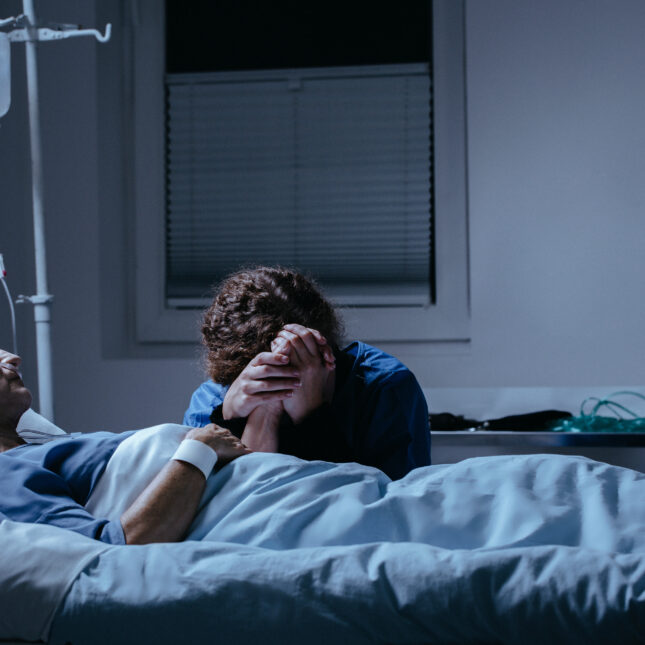
The distress from receiving a cancer diagnosis is something that clinicians widely anticipate in patients, but suffering often doesn’t just afflict the patient. It can blanket an entire household, burdening spouses and other family members with stress and anxiety and the exhausting routine of treating a life-threatening disease.
But while standards exist for assessing and managing distress in patients, it’s often “hidden” in family members, sometimes with devastating consequences, said Weiva Sieh, an epidemiologist at MD Anderson Cancer Center. In a study published in JAMA Oncology on Thursday, spouses of cancer patients were found to be at significantly higher risk of suicide attempt and death compared to those married to people without cancer.
“Psychosocial distress in cancer patients themselves are better anticipated, widely known, and accepted,” said Sieh, who did not work on the study but wrote an accompanying editorial in JAMA Oncology. “This problem is not extremely well recognized. Fortunately, mental health is often treatable. It’s just a question of recognizing it.”
To do the study, researchers used data from national patient databases in Denmark, which made it possible for them to see people in the registry who were diagnosed with any kind of cancer, those individuals’ spouses, and their history of psychiatric care. When they analyzed the data, the scientists found spouses had a 1.28-fold increased risk for suicide attempt and 1.47-fold increased risk for suicide death compared to people whose spouses never had cancer.
That risk varied based on a few factors, said Fang Fang, a professor of epidemiology at the Karolinska Institute in Sweden and the senior author on the study. When patients had more aggressive cancers, their spouses were at greater risk for suicide attempts and deaths, whereas there wasn’t a significant increase in risk associated with cancer types that had better prognoses, she said. “If you have a diagnosis of really bad cancers like pancreas the risk is higher. The risk is also higher right after diagnosis,” she said.
According to the study’s analysis, the spouse’s risk of suicide attempt went up 1.45 times and the risk of suicide death went up 2.56 times in the first year after cancer diagnosis — though an elevated risk remained throughout the 30-year study period.
Suicide is generally a rare outcome. In this study, there was an absolute increase of roughly 16 suicide deaths per 100,000 people per year — a small increase overall — but that doesn’t diminish the weight of this observation. Each of those lives are important, the experts stressed, and observed statistical increases in suicide risks are often indicators of a much broader unmet mental health need. “Any increase in suicide risk is kind of the tip of the iceberg,” said MD Anderson’s Sieh. “A significant increase in suicide — what does that mean about the large numbers of people who are suffering from depression who don’t commit suicide?”
In this study, that observed increase “shines a really important light on how severe it can get for cancer caregivers,” said Alyson Moadel-Robblee, a psychologist at Montefiore Einstein Comprehensive Cancer Center who did not work on the paper. “For people who don’t have support, it can go down a really dark road.”
Cancer brings with it a world of burdens on patients and their primary caregivers, who are often spouses. There can be unexpected, sometimes even bankrupting financial expenses associated with treatment. There’s navigating the byzantine health care system and crash courses on oncology jargon and medical knowledge.
“On top of that, you’re thinking about your loved one, who might die or be dying of cancer. It’s extremely scary. A lot of family members, particularly spouses, have a sense of helplessness,” Moadel-Robblee said. “If you see someone suffering, and you can’t fix it and you don’t know how to reach out for help or label your emotions, and you don’t know if it’s depression and that it’s treatable, you may hide it. And if you do that, it can get a life of its own.”
In extreme cases, Moadel-Robblee said, that can spiral towards suicide ideation, attempts, and death. Though theoretically anyone could find themselves in this kind of cycle, Moadel-Robblee said some people are more vulnerable to it than others. That bore out in this study, as well, as people with a prior history of psychiatric illness appeared to be at greater risk for suicide attempts and deaths after their spouse’s cancer diagnosis.
That suggests there may be a few key touchpoints where clinicians can target for interventions on family distress in cancer, like bringing more resources to families and spouses in the first year after a diagnosis, screening for individuals who have a history of mental health disorders, and focusing on families facing a worse prognosis. That may be easier said than done, though, Moadel-Robblee pointed out.
At the moment, mental health services in oncology are much more focused on the patient, rather than the family, she said. “Not every cancer center has a caregiver support program,” she said. Even some of the resources that centers offer may be difficult for primary caregivers to take advantage of, Moadel-Robblee added.
“We do offer a caregiver support group, and they don’t often come because they’re too busy. They’re working and caregiving. It’s a catch-22,” Moadel-Robblee said. “There’s not that sort of practical intervention that’s needed to help caregivers. That’s a whole other area we can figure out.”
When people can offer it, informal support can make a big difference. “If it’s a friend,” Moadel-Robblee said. “The best thing you can do is say: ‘Tell me how you’re feeling. I may not be able to help, but I am here to listen. Can I cook for you? Help with laundry? Anything that is practical?’ That’s a huge intervention.”
If you or someone you know may be considering suicide, contact the 988 Suicide & Crisis Lifeline: call or text 988 or chat 988lifeline.org. For TTY users: Use your preferred relay service or dial 711 then 988.






